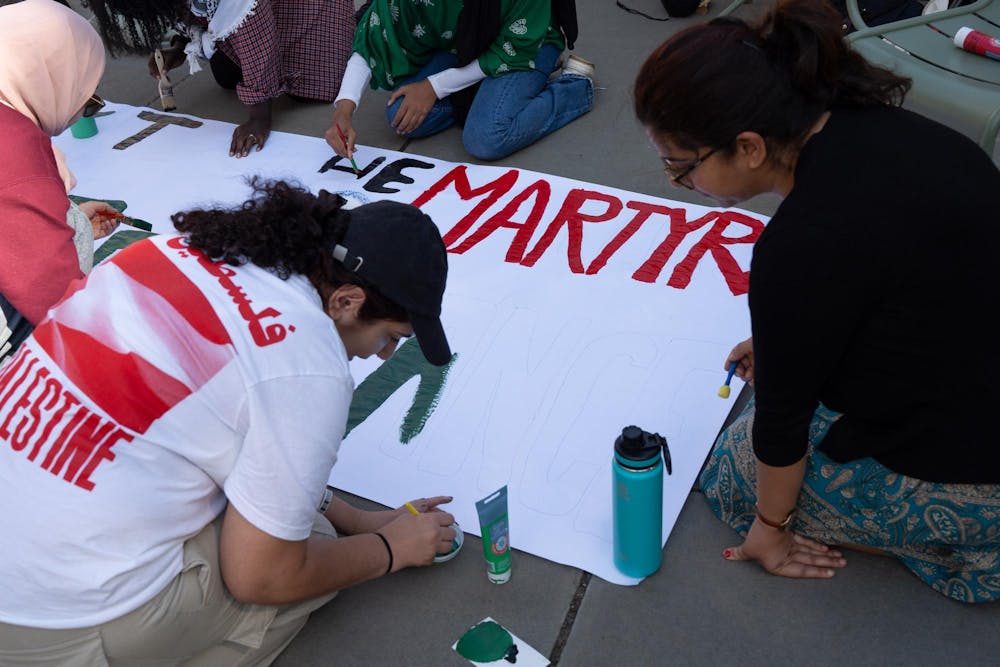Several pro-Palestine student organizations held sparsely attended demonstrations on campus on the days leading up to Monday, Oct. 7, which marks one year since Hamas’s attacks on Israel and the subsequent war in Gaza.
About 15 people gathered in Firestone Plaza on the early afternoon of Oct. 7 to paint a large banner reading, “Glory to the martyrs, glory to the resistance” and read aloud the names and ages of Palestinian children killed by the Israeli military in the past year.
In a social media post, organizers framed the event as commemorating “one year of genocide, 76 years of occupation.”
“Oct. 7 will go down in human history as commemorating all sorts of loss. And I think it’s also important in the historical context we live in to frame it as one of the first and most momentous ruptures of a colonial world order … a violent, heinous rupture, that still happened under the auspices of an anti-colonial movement,” Aditi Rao GS, an organizer with Princeton Israeli Apartheid Divest (PIAD) present at the demonstration, said when asked about the meaning of the banner.
“That anti-colonial movement holds the name resistance, and everything that has transpired in the past year is a part of that movement … to have a liberated Palestinian people who live on the liberated Palestinian land,” she added.
A few people passed out flyers to bystanders encouraging students, alumni, and other University affiliates to submit support for divestment from Israel to the Resources Committee of the Council of the Princeton University Committee (CPUC), which is considering a proposal submitted over the summer. Talking points included, “[e]very minority group should be worried about how this issue is being treated,” and “consensus is a stupid concept to begin with.”
A different group of around 30 students, with some overlap with Monday’s participants, participated in a die-in in the plaza on Saturday, Oct. 5 as part of an International Day of Action campaign supporting Palestine.
“It’s deeply painful to hear the names of the 725 martyrs that we only got a chance to read, 724 of them being all under the age of one,” Amber Rahman ’25, who attended the die-in, said. “To know that this has gone on for close to one year and our University has not moved one inch on divestment is deeply painful, and they will pay the price one day.”


Pro-Palestine protesters organized a die-in on Saturday, Oct. 5 in Firestone Plaza.
Miriam Waldvogel / The Daily Princetonian
Protesters opted for silence at a study-in on Sunday in the Trustee Reading Room, taping signs to the backs of their laptops which included statements such as “All of the universities in Gaza have been destroyed,” “‘Israel’ is committing scholasticide: there are no midterms in Gaza,” and “While we’re learning, Lebanon’s burning.” Some protestors wore keffiyehs, and one student taped a small Palestinian flag to a desk lamp. Students not involved in the study-in continued to study for midterms quietly nearby.
At least 15 students participated in the study-in, held across two sessions that afternoon.
Before the study-in began, a few Public Safety (PSAFE) officers were stationed outside Firestone Library and the Trustee Reading Room, but did not interact with protesters.


A Palestinian flag affixed to a lamp in the Trustee Reading Room on Sunday.
Jean Shin / The Daily Princetonian
Study-ins at other universities have garnered considerably more controversy. At Harvard, more than 12 students were banned from the school’s Widener Library for two weeks after staging a study-in last month.
Princeton’s protest policy states that protest activities in libraries and similar facilities “must be conducted in a manner that respects the necessity for maintaining a reasonable degree of quiet in such areas.”
Participation at this week’s protests was lower compared to previous pro-Palestine demonstrations this semester. These include a vigil hosted by Princeton Students for Justice in Palestine (SJP) on Sept. 30, which drew approximately 100 attendees.
While most of this week’s actions occurred near Firestone, some University employees arriving to work Monday morning were greeted by pro-Palestine graffiti at the entrance to 22 Chambers St., where the Princeton University Investment Company (PRINCO) is headquartered.
Red paint was splattered across the doorway and black lettering read “$4Genocide.” PIAD posted a photo of the graffiti on their Instagram story with the caption, “new decor at the Princo building.”

22 Chambers St. on the morning of Monday, Oct. 7.
Miriam Waldvogel / The Daily Princetonian
The graffiti was reported to PSAFE at 6:44 a.m. on Tuesday morning, according to the agency’s daily crime log. By about 10:30 a.m., a worker was seen power-washing the graffiti off the building and sidewalk.
University spokesperson Jennifer Morrill confirmed that the incident was under investigation.
Miriam Waldvogel is an associate News editor and the investigations editor for the ‘Prince.’ She is from Stockton, Calif. and often covers campus activism and University accountability.
Annie Rupertus is a head News editor for the ‘Prince’ from Philadelphia, Pa. who often covers activism and campus governance.
Nikki Han is a News contributor for the ‘Prince.’
Please send any corrections to corrections[at]dailyprincetonian.com.








